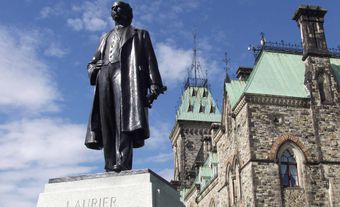Yukon
Lying in the northwestern corner of Canada and isolated by rugged mountains, the Yukon borders Alaska to the west, British Columbia to the south and the Northwest Territories to the east. Historically, it is indelibly associated with the great Klondike Gold Rush.
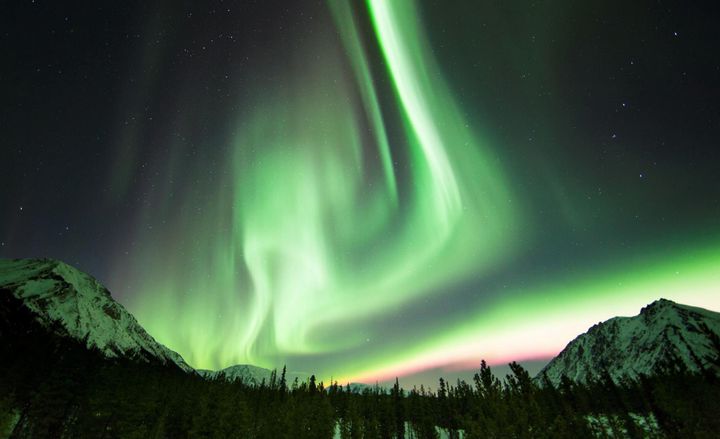
-
October 18, 1867
Government and Politics
Purchase of Alaska
The United States took possession of 1,518,800 km2 of land purchased from Russia for $7.2 million. Located at the northwestern corner of North America, the lands comprise what is now the US state of Alaska. Negotiations for the sale had begun in March.
-
July 31, 1868

Government and Politics
Rupert's Land Act
The Rupert's Land Act was passed, allowing the Crown to declare Rupert's Land part of the Dominion of Canada.
-
December 01, 1869
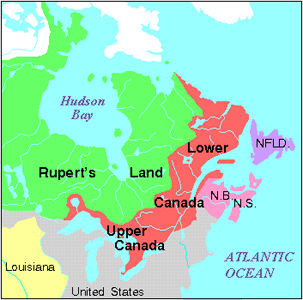
Government and Politics
HBC Surrenders Rupert's Land
The Hudson's Bay Company surrendered Rupert's Land to the Canadian government.
-
July 15, 1870

Government and Politics
Transfer of Rupert's Land
The British Crown officially transferred Rupert's Land and the North-Western Territory to Canada. These lands comprise present-day Manitoba, most of Saskatchewan, southern Alberta, southern Nunavut, and northern parts of Ontario and Québec.
-
May 08, 1871
Resources and Environment
Treaty of Washington
The Treaty of Washington granted Americans fishing rights in Canadian waters and the use of Canadian canals and the St Lawrence River. Canadians were allowed to navigate Lake Michigan, the St Clair Flats Canal and Alaskan rivers.
-
May 23, 1873

Government and Politics
North-West Mounted Police
An Act of Parliament authorized the creation of the North-West Mounted Police; the prefix Royal was added 1904.
-
April 08, 1875
Government and Politics
North-West Territories Act
The North-West Territories became a political entity separate from Manitoba. The territory would have its own lieutenant-governor and council.
-
March 27, 1883
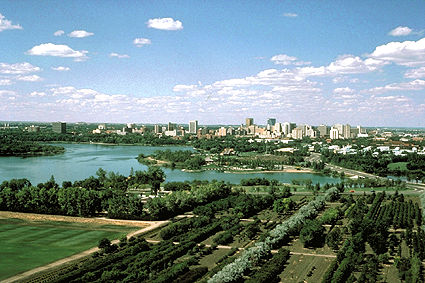
Government and Politics
Capital of the North-West Territories Shifts
The capital of the North-West Territories (the future Alberta and Saskatchewan) shifted from Battleford to Pile O' Bones (Regina). Cree hunters harvested buffalo in the region and stacked the bones of their quarry in piles roughly 2 m tall by 12 m in diameter. The Cree believed that buffalo herds would return to visit these bones, and so named the area Oskana-Ka-asateki, "the place where bones are piled."
-
January 01, 1895
Government and Politics
Yukon is Named one of Four NWT Districts
Canada named Yukon one of four districts within the Northwest Territories, along with Mackenzie, Franklin and Ungava. The capital of the territory was in Regina, but Yukon people sought more control over their affairs.
-
August 17, 1896

People Resources and Environment
Klondike Gold Rush Begins
George Washington Carmack, Skookum Jim and Tagish Charlie discovered gold on Bonanza Creek, a tributary of the Klondike River. During the Klondike Gold Rush from 1897 to 1899 at least 100,000 people stampeded to the gold fields.
-
May 06, 1898
People Resources and Environment
Yukon Field Force
The Yukon Field Force, consisting of 203 volunteers, left Vancouver for Dawson to maintain order during the Klondike Gold Rush.
-
June 13, 1898

Government and Politics
Yukon Becomes Separate Territory
By Act of Parliament the Yukon became a separate territory with a commissioner and partly elected council.
-
July 29, 1900
Communication and Transportation
White Pass and Yukon Railway
The last spike was driven on the White Pass and Yukon Railway, which ran from Skagway to Whitehorse.
-
October 20, 1903

Government and Politics
Alaska Boundary Dispute
Settlement of the Alaska-Canada boundary dispute established the Alaska-Canada border as it is today. The border denied Canada access to the sea in both northern BC and the Yukon.
-
May 20, 1919
Government and Politics
Yukon Women Get Vote
Yukon women won the right to vote and seek elected office.
-
July 12, 1920

Sports and Culture
Birth of Pierre Berton
Journalist, historian and media personality Pierre Berton, was born at Whitehorse, Yukon.
-
February 17, 1932
People
Mad Trapper Shot
Albert Johnson, the "Mad Trapper," was shot and killed by the RCMP on the Rat River, northern Yukon Territory.
-
November 20, 1942
Communication and Transportation
Alaska Highway Opens
The Alaska Highway, which winds across 2,451 km of mountain wilderness from Dawson Creek to Fairbanks, Alaska, was opened to military traffic.
-
February 03, 1947
Resources and Environment
Snag Sets Record Low
The lowest temperature in North America was recorded at Snag, Yukon, at -63° C (-83° F).
-
January 01, 1953
Government and Politics
Capital of Yukon Moves to Whitehorse
As the gold rush quickly faded in the early 1900s, many settlers left Yukon. Dawson City’s busy commercial life collapsed, leaving a much-reduced near-ghost town. In 1953, the capital was moved to Whitehorse.
-
January 03, 1959
Government and Politics
Alaska Becomes a State
Alaska became the 49th state of the United States.
-
September 11, 1967
Government and Politics
First Woman Elected to the Yukon Territorial Council
Jean Gordon became the first woman elected to the Yukon Territorial Council.
-
March 11, 1969
Communication and Transportation
Last RCMP Dog Sled Patrol
The last RCMP dog sled patrol, which mostly carried mail and medical supplies across the Yukon and Northwest Territories, set out on a final 800 km round trip from Old Crow, YT. Constables Warren Townsend and Peter Benjamin made the trip in 26 days with two dog teams. The RCMP had recently announced that its last dog sled teams would be replaced with snowmobiles and aircraft.
-
January 01, 1972
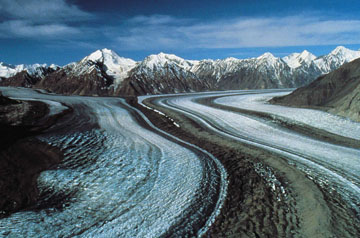
Resources and Environment
Kluane National Park and Reserve Established
Kluane National Park and Reserve was established. The park is an area of unclimbed peaks, vast ice fields, clear lakes, glaciers and spectacular wildlife. Tucked in the southwest corner of the Yukon Territory, 150 km west of Whitehorse, the park contains Canada's highest peak, Mount Logan. It is named after the Yukon's largest lake, which borders the park.
-
February 14, 1973

Indigenous Peoples
Yukon Land Claims
The federal government established a committee to negotiate land claims in the Yukon.
-
January 20, 1979
Government and Politics
First Female Territorial Commissioner
Ione Christensen became the first female territorial commissioner (Yukon).
-
August 18, 1979

Communication and Transportation
Dempster Highway Opens
The Dempster Highway officially opened in Flat Creek, Yukon. The first all-weather road to cross the Arctic Circle took 20 years to build and required the assistance of the Canadian Forces.
-
January 01, 1984

Resources and Environment
Ivvavik National Park Established
Ivvavik National Park was established. Initially known as Northern Yukon National Park, it was given an Inuvialuit name in 1992. It is Canada's first park established through a native land claim settlement.
-
April 22, 1992
Indigenous Peoples
Gwich’in Comprehensive Land Claim Agreement
The Gwich’in Tribal Council and the Canadian and the Northwest Territories governments signed the Gwich’in Comprehensive Land Claim Agreement. The Agreement involved lands in the Mackenzie Delta in the Northwest Territories and in Yukon. Special hunting rights were also extended, permitting the harvest of fur-bearing animals throughout the settlement area.
-
October 26, 1992
Government and Politics
Referendum Rejects Charlottetown
Six provinces and the Yukon rejected the Charlottetown Accord in a national referendum.
-
April 17, 2000
Government and Politics
First Female Premier of the Yukon
Patricia (Pat) Duncan became the Yukon’s first female premier at the head of the territory’s first Liberal government.
-
January 01, 2003
Government and Politics
Yukon Act Amended
The Yukon Act was amended so that the territory became the first to formally take control of its land and resources.
-
October 18, 2003
Indigenous Peoples
Kluane First Nation Land Claim
The Kluane First Nation signed a finalized land claims and self-government agreement with the Canadian and Yukon governments. The Kluane First Nation is located at Burwash Landing, a former trading post. Among the Final Agreement’s many objectives was the preservation of Yukon First Nations’ cultural heritage and language.
-
April 14, 2017
People
Death of James Smith
James Smith, Commissionner of Yukon from 1966 to 1976, died at the age of 97. Smith was a joint founder of the Arctic Winter Games.



